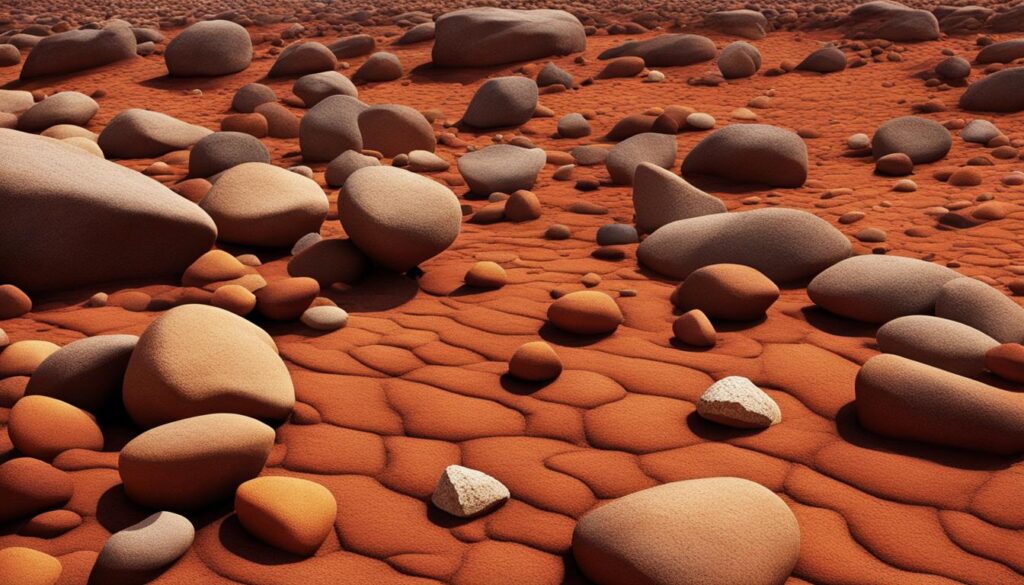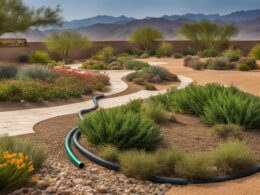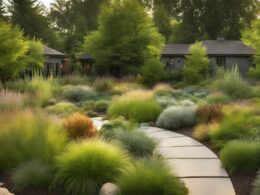Welcome to our master guide on mulching in arid climates, where we will provide you with effective techniques to improve soil fertility and conserve water. Mulching in arid climates requires specific considerations and practices to ensure optimal results. By following the right methods and using suitable materials, you can create a thriving garden even in dry conditions. Read on to discover the key strategies for successful mulching in arid climates.
Key Takeaways:
- Choose the right mulching materials for the specific needs of your plants in arid climates.
- Proper mulching techniques, such as determining the right mulch depth and creating proper edging, are crucial for success.
- Considerations like wind resistance, nitrogen availability, and plant diseases must be taken into account when mulching in arid climates.
- Organic mulches offer additional benefits in terms of soil enhancement, increased fertility, moisture retention, and weed control.
- Mulching in arid climates helps improve soil fertility and conserve water, leading to healthier plants and a more sustainable garden.
Benefits of Mulching in Arid Climates
Mulching in arid climates offers a wide range of benefits that contribute to the health and vitality of your garden. One of the key advantages is the promotion of soil microorganism activity. Mulch serves as a protective layer, creating a suitable environment for beneficial microorganisms to thrive. These microorganisms play a crucial role in breaking down organic matter, releasing essential nutrients into the soil that are necessary for plant growth.
Another significant benefit of mulching in arid climates is soil moisture stabilization. The mulch acts as a barrier, reducing the evaporation of water from the soil surface. This helps to maintain a more consistent level of moisture, preventing the soil from drying out quickly and ensuring that plants have access to the water they need.
Weed suppression is another advantage of mulching. By covering the soil surface with a layer of mulch, you create an inhospitable environment for weed seeds to germinate. This reduces the competition for water, nutrients, and sunlight, allowing your desired plants to thrive without the interference of invasive weeds.
Furthermore, mulching in arid climates improves water infiltration. When rainwater or irrigation is applied, the mulch helps to slow down the flow of water, allowing it to penetrate the soil gradually. This prevents runoff and allows the water to be effectively absorbed by the roots of plants, maximizing its use and conserving water resources.
| Benefits of Mulching in Arid Climates | |
|---|---|
| Soil Microorganism Activity | Enhanced soil fertility through the breakdown of organic matter |
| Soil Moisture Stabilization | Reduced evaporation, maintaining consistent soil moisture levels |
| Weed Suppression | Prevention of weed growth, reducing competition for resources |
| Water Infiltration | Improved absorption of water, reducing runoff and conserving water |
Choosing the Right Mulching Material
When it comes to mulching in arid climates, selecting the appropriate mulching material is crucial for the success of your gardening endeavors. Different mulches offer various benefits and suit different types of plants. Here are some common mulching materials to consider:
Wood Chip Mulch
Wood chip mulch provides excellent insulation for plant roots, helping to retain moisture in the soil. It also breaks down slowly, providing long-term benefits to the soil’s organic matter content.
Bark Mulch
Bark mulch is aesthetically pleasing and acts as a natural weed suppressant. It helps to regulate soil temperature and retains moisture, making it a great option for arid climates.
Rock Mulch
Rock mulch is an ideal choice for drought-tolerant plants as it aids in water conservation by reducing evaporation. It can also provide a unique aesthetic appeal to your garden.
Grass Clipping Mulch
Grass clipping mulch is a cost-effective and sustainable option as it utilizes the byproduct of lawn mowing. It adds nutrients to the soil as it decomposes and helps suppress weed growth.
Leaf Mulch
Leaf mulch acts as a natural fertilizer and soil conditioner. It enriches the soil with organic matter and helps prevent weed growth while retaining moisture.
Consider the specific needs of your plants, the aesthetic appeal you desire, and the availability of mulching materials in your area when selecting the right mulching material for your garden in arid climates. Remember to apply a layer of mulch that is around 2-4 inches deep, ensuring proper coverage and retention of moisture.
Proper Mulching Techniques for Arid Climates
When mulching in arid climates, it is crucial to follow proper techniques to ensure the best results for your plants and garden. Understanding mulch depth, edging and soil grade, converting lawn to mulch, and fire-resistant landscaping are key factors to consider. By implementing these techniques, you can optimize water conservation, improve soil fertility, and protect your plants from extreme weather conditions.
Mulch Depth
The depth of mulch plays a vital role in providing adequate insulation and moisture retention for your plants. For arid climates, it is recommended to apply a mulch depth of 3 to 4 inches. This thickness helps to prevent excessive evaporation and temperature fluctuations, keeping the soil moist and cool. However, be cautious not to apply too much mulch, as it can suffocate the roots and lead to waterlogging.
Edging and Soil Grade
Proper edging is necessary to maintain the mulch in place and prevent erosion. It helps create a clean and defined border, keeping the mulch from spilling onto sidewalks or other areas. Additionally, pay attention to the soil grade, ensuring that it slopes away from your house or structures to prevent water accumulation. This slope allows for efficient water drainage and reduces the risk of foundation damage.
Converting Lawn to Mulch
If you’re considering converting your lawn to mulch in an arid climate, follow these steps for a successful transformation. First, mow the lawn as short as possible and remove any leftover debris. Then, add a layer of cardboard or newspaper to suppress weed growth. Next, apply the desired mulch layer and make sure to water it thoroughly. This process helps smother existing grass, conserves water, and improves soil quality.
Fire-Resistant Landscaping
In areas prone to wildfires, fire-resistant landscaping techniques are crucial. When mulching in arid climates, consider using non-combustible materials such as rocks or gravel near your house. These materials act as a barrier, reducing the risk of fire spreading. Additionally, avoid using flammable mulch materials, such as pine needles or dry leaves, in fire-prone regions. Instead, opt for mulches made from dense wood chips or bark.
| Technique | Advantages |
|---|---|
| Mulch Depth | Prevents evaporation, stabilizes soil temperature |
| Edging and Soil Grade | Controls mulch spreading, improves water drainage |
| Converting Lawn to Mulch | Conserves water, suppresses weed growth |
| Fire-Resistant Landscaping | Reduces fire risk, protects property |
Considerations for Mulching in Arid Climates
When mulching in arid climates, it’s important to consider certain factors to ensure the success of your gardening efforts. One consideration is the use of wood chip and bark mulch in dry conditions. While these mulches offer many benefits, they may be affected by intense sunlight and the lack of moisture in arid environments. Therefore, it’s essential to monitor their moisture levels and provide additional irrigation if needed to prevent them from drying out.
Another consideration is wind resistance. Arid climates are often characterized by strong winds, which can displace lightweight mulch materials. To mitigate this, consider using heavier mulch options or securing the mulch with a layer of landscape fabric or a thick layer of soil beneath it.
Nitrogen availability is also an important consideration when mulching in arid climates. Wood chip and bark mulch can temporarily tie up nitrogen in the soil as they break down, potentially affecting the growth of nitrogen-sensitive plants. To prevent this, consider incorporating additional nitrogen sources such as organic fertilizers or using a high-nitrogen mulch like grass clippings in combination with the wood chip or bark mulch.
Lastly, plant diseases can be a concern when mulching in arid climates. While mulch can help suppress weeds and reduce the risk of soil-borne diseases, it’s important to use disease-free mulch materials to prevent the spread of pathogens. Make sure to source your mulch from reputable suppliers and avoid incorporating mulch from diseased plants or infected areas.
Table: Comparing Mulch Considerations in Arid Climates
| Consideration | Wood Chip and Bark Mulch in Dry Conditions | Wind Resistance | Nitrogen Availability | Plant Diseases |
|---|---|---|---|---|
| Impact of Dry Conditions | May dry out quickly, requiring additional irrigation | Not applicable | Not applicable | Not applicable |
| Wind Resistance | May require additional anchoring or heavier mulch options | Lightweight mulch materials may be displaced | Not applicable | Not applicable |
| Nitrogen Availability | May temporarily tie up nitrogen in the soil | Not applicable | Additional nitrogen sources may be required | Not applicable |
| Plant Diseases | Not applicable | Not applicable | Not applicable | Use disease-free mulch materials to prevent pathogen spread |
By taking these considerations into account, you can successfully mulch in arid climates and reap the benefits of improved soil moisture retention, weed suppression, and overall plant health.
Benefits of Organic Mulches in Arid Climates
When mulching in arid climates, the choice of organic mulches, such as wood chips, bark, and compost, can offer numerous benefits. These mulches not only enhance soil structure but also contribute to increased fertility, moisture retention, and effective weed control.
Organic mulches act as natural soil enhancers by gradually breaking down and enriching the soil with essential nutrients. As they decompose, they release organic matter and micronutrients, improving the overall fertility of the soil. This nutrient-rich environment promotes the growth and health of plants, enabling them to thrive in arid conditions.
Moisture retention is crucial in arid climates where water scarcity is a common challenge. Organic mulches play a vital role in conserving moisture by reducing evaporation from the soil surface. They create a protective barrier that shields the soil from direct sunlight, preventing rapid water loss and maintaining a more consistent moisture level. This allows plants to access the water they need for growth and survival, even during dry periods.
Furthermore, organic mulches provide effective weed control in arid climates. By covering the soil surface, they prevent weed seeds from germinating and accessing sunlight, ultimately suppressing weed growth. This reduces the competition for water and nutrients, ensuring that the desired plants receive ample resources for optimal growth.
Summary:
- Organic mulches, including wood chips, bark, and compost, offer numerous benefits in arid climates.
- They enhance soil structure, increasing fertility and promoting the growth of healthy plants.
- Organic mulches help retain moisture, reducing water evaporation and ensuring consistent hydration for plants.
- They also provide effective weed control by suppressing weed growth and reducing competition for resources.
| Benefits of Organic Mulches in Arid Climates |
|---|
| Soil Enhancement |
| Increased Fertility |
| Moisture Retention |
| Weed Control |
What Are the Key Differences Between Mulching in Arid Climates and Sustainable Mulching for Arid Environments?
When comparing traditional mulching in arid climates to sustainable mulching for arid environments, the key differences lie in their water conservation and environmental impact. Sustainable mulching for arid environments focuses on utilizing organic materials and techniques that promote water retention and soil health, while traditional mulching may not prioritize these sustainable practices.
Conclusion
In summary, mulching in arid climates is a highly effective technique for improving soil fertility and conserving water. By following the right mulching materials and techniques, considering specific factors, and utilizing organic mulches, you can achieve successful results in your garden.
Effective soil fertility is one of the key benefits of mulching in arid climates. By applying the proper mulch depth and choosing suitable materials like wood chips, bark, or compost, you can enhance soil structure and increase fertility. These organic mulches also help retain moisture in the soil, reducing the need for frequent watering and contributing to water conservation efforts.
Furthermore, mulching in arid climates provides additional advantages beyond soil fertility and water conservation. Proper mulching techniques help suppress weeds and control erosion, resulting in a well-maintained and visually appealing garden. It also moderates soil temperature extremes, creating a more favorable environment for plant growth.
To achieve the best results, it is important to consider factors such as intense sunlight, wind resistance, nitrogen availability, and plant diseases when choosing and applying mulches in arid climates. By taking these considerations into account, you can ensure that your mulching efforts are optimized for your specific climate and gardening needs.














